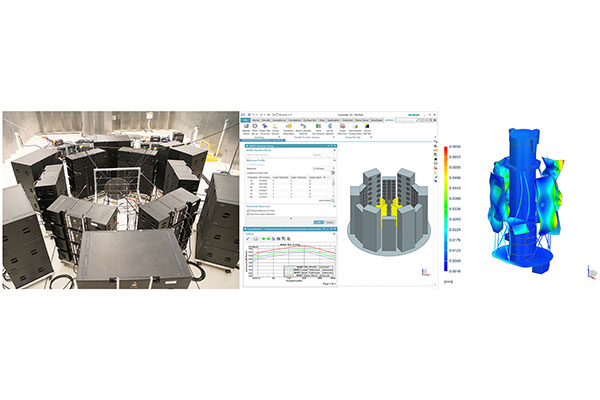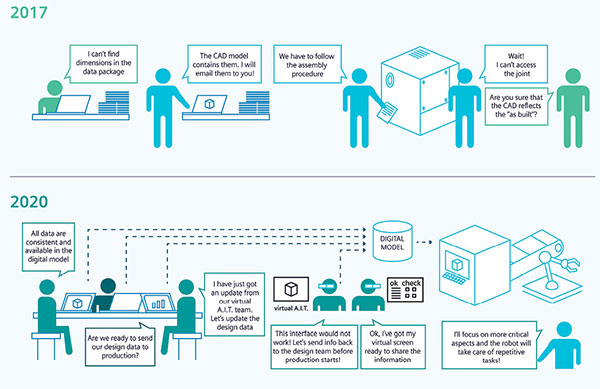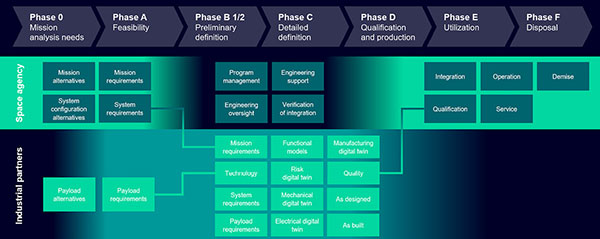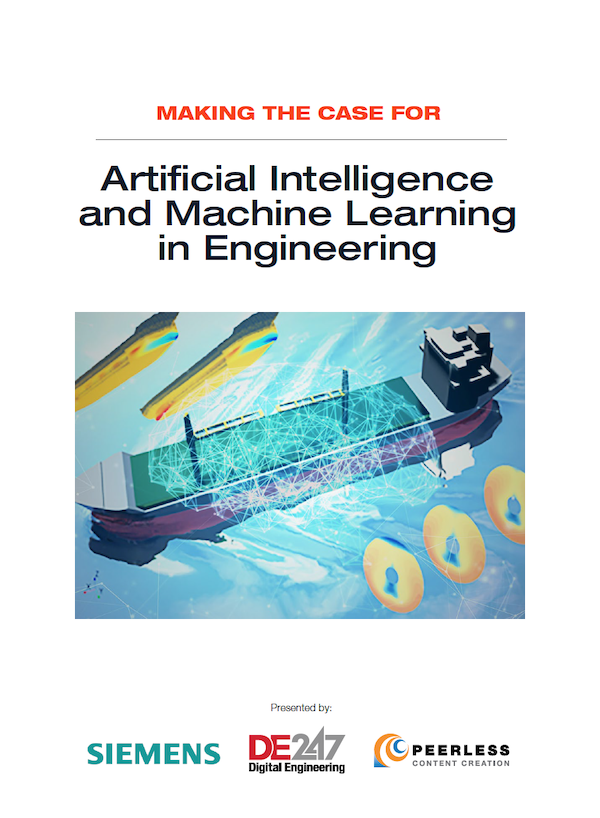
Simulation and testing are an essential part of Siemens digital thread technologies and are included in the Xcelerator portfolio of solutions. Image courtesy of Siemens.
Latest News
May 13, 2022
Because of accelerated privatization over the past 20 years, the space industry has entered a new era. Launch prices have dropped, and the space sector is evolving into a capital-driven economy. Simultaneously, government investment has increased, and the desire for crewed exploration hasn’t gone away.
This evolution has shaken up the fundamentals of space systems engineering, making it a competitive, business-driven field. Dealing with complexity, time and cost are now emerging as major priorities. In these tumultuous times, the justification for value-added services and products that can result from investment in space technologies will be in the spotlight.
Digital technology solutions can help space agencies and businesses move faster, effectively explore innovative solutions, handle process and product complexity, and integrate all stakeholders.
Product Engineering Priorities

Accelerated privatization has dramatically and quickly changed the entire space industry. It created enormous opportunities for new applications and ambitions. Business is booming, and tremendous growth is expected during this decade, tripling by 2030.1 How does this change affect priorities in product engineering? How can traditional public agencies remain relevant, and where are the opportunities for newcomers to successfully take a share?
Reducing Time, Cost and Risk
Where public agencies often struggle most is the newer emphasis on typical market-driven priorities such as time and cost, especially in relation to risk. Risk is a natural priority for space engineering, but new challenges emerge with the ambition to send astronauts to the moon and Mars.
For decades, agencies were focused on delivering excellence against certain budgets. Their primary customers were mostly public entities, such as defense departments, meteorologic institutes and large public service providers. Downstream services and applications came as collateral business.2

In this new space era, the end price dictates the business. Being commercially successful requires low cost, a different approach to risk and more agile, customer-oriented business models. This is where typically traditional players have difficulties, and where newcomers see opportunities.
Comprehensive digitalization during design and manufacturing is crucial to save time and costs at the product and process level. By using a digital twin, with integrated models and testing, companies can dramatically reduce time to market by shortening the decision-making process, development time and qualification testing loops.3
With digital modeling and testing, design teams can conceive, manufacture and use products more efficiently. Digital technologies can be used to incorporate processes that foster automation, mass manufacturing of components, systems-driven approaches, reusability, predictive maintenance, feedback loops, additive manufacturing and collaboration between mechanical and electrical engineering. All these capabilities will play a crucial role for companies and agencies to be competitive in the new space era.
Exploring Innovative Ideas
Driven by a commercial context, newcomers often bring ideas that question established ways of doing things, for example, reusable launch systems or large constellations of small satellites.
Realizing such ideas in the physical world involves working within the constraints of time and cost and takes a lot of engineering work. This includes defining requirements, studying concepts, exploring architectures, refining designs, making them real products and following their evolution until the end of life.
A large part of this work can be done virtually, based on large amounts of data. This approach requires powerful exploration tools and scalable simulation methods, as well as a digital platform that connects all lifecycle components. However, such digital technologies are precarious when developing equipment in the framework of large space exploration programs.
These programs usually start by setting goals rather than by setting targets. Looking at what is in the pipeline to happen before 2030, there is a lot of “what” and “why.” But the “how” is often unknown—and requires a discovery process.
Space agencies even speculate on the expected evolution in various technology fields when making plans and setting deadlines. That is what makes developing for space so interesting to engineers, and why the industry is always at the forefront of innovation, contributing to pure research. This level of development requires a strong digital platform to capture all ideas, collect them, simulate them and develop them on time and within budget, while keeping on track.
Dealing with Complexity
Most space systems are complex by nature. They include advanced materials and combine a multitude of physics. Consider highly controlled propulsion systems, for example, or robotic systems with built-in artificial intelligence.
So many parameters are involved in their development that engineers need a digital twin to come close to success. At the heart of this digital twin are realistic, prediction-capable simulation models to optimize all system aspects simultaneously, from the beginning of the design cycle.
As some of these systems are smart, they evolve over time. They include many sensors to further optimize performance during operation. Smart systems also communicate with each other and their environment, and they feed information back to design teams for future improvement and predictive maintenance.
This system behavior requires management of massive amounts of data and using analytics in a digital solution that spans the entire product lifecycle. In addition, space systems are intended to operate in the harsh environment of space.
Equipment that leaves the Earth’s protective atmosphere will be exposed to different gravity conditions, extreme temperature fluctuations, cosmic radiation and more conditions that we have yet to consider. Any engineering work on space-bound systems needs to take this complexity into consideration. Applications or materials that in other industries would be labeled as advanced or exotic are the standard for space development.
Using a digital twin approach during product design and development requires high-performance simulation software. Only those solutions that specifically address the typical space engineering requirements will suffice, but there are only a handful of such solutions on the market. For this reason, commercially available software is often combined with in-house tools, adding another layer of complexity of tool integration.
Integrating Different Partners
Large space programs involve intense collaboration among diverse stakeholders, such as alliances, partnerships and subcontractors. All have their own data, processes, methods and tools. Without proper integration such collaborations are prone to errors.
Data management and integration are challenging for many companies. Accenture conducted a survey among aerospace and defense executives and concluded that nearly 74% of them feel overwhelmed by the amount of available data coming from products and services. Accenture concluded that digitalization technologies can help companies leverage data to generate more valuable insights, improve decision making and reduce manufacturing costs.4
Achieving Space Program Excellence
An overarching digital infrastructure, in which all data for the various product lifecycle phases are collected, managed, kept up to date and accessible to relevant program stakeholders benefits space system-engineering priorities tremendously. This type of platform weaves an all-encompassing digital thread of information from requirements definition to exploration, through the detailed design process, manufacturing, qualification, certification and beyond.
A digital twin enables connecting a product in space to its original requirements and to trace the effects of all decisions and actions taken throughout the program.
Because of its openness, flexibility and ability to deliver solutions for every product lifecycle aspect, and because these solutions can easily be integrated in a digital thread, the Xcelerator portfolio from Siemens can be used for any space program as a unified digital platform to manage all data and user privileges. This comprehensive and integrated portfolio of software, services and application development platform is designed to speed digital transformation. If you’re interested in finding out more about these solutions, download this white paper.

Thierry Olbrechts is Director, Siemens Simcenter Aerospace Industry Solutions.
More Siemens Digital Industries Software Coverage
Subscribe to our FREE magazine, FREE email newsletters or both!
Latest News






